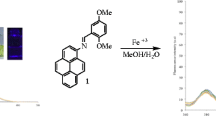Abstract
A naked-eye colored chemodosimeteric probes 4a-f, based on Schiff-azo dye conjugates were synthesized and characterized. All compounds 4a-f exhibited excellent selectivity and high sensitivity in absorbance toward detection of Fe3+ in alcoholic solutions under neutral pH conditions. The detection limit of the probe was shown to be up to 0.05 ppm. A simple paper test strip system for the rapid monitoring of Fe3+ was developed, indicating their convenient use in environmental samples. Electrochemical analysis of metal free conjugates and iron chelated probes confirmed the chelation of ligands.

Graphical Abstract
















Similar content being viewed by others
References
Gokel GW, Leevy WM, Weber ME (2004) Chem Rev 104:2723–2750
Petit JM, Van Wuytswinkel O, Briat JF, Lobreaux S (2001) J Biol Chem 276:5584–5590
Tasuku H, Nagasawa H (2017) J Clin Biochem Nutr 60(1):39–48
Long JC, Sommer F, Allen MD, Lu SF, Merchant SS (2008) Genetics 179:137–147
Cho JS, Hsu JV, Morrison SL (2009) Immunotherapy 58:1057–1069
Toral MI, Richter P (1995) Anal Lett 28:1083–1094
Kumar CV, Asuncion EH (1993) J Am Chem Soc 115:8547–8553
Kedar NA, Shirodkar SG (2014) J Chem Pharm Res 6:801–807
Chatterjee A, Santra M, Won N, Kim S, Kim JK, Kim SB, Ahn KH (2009) J Am Chem Soc 131:2040–2041
Chen X, Hong H, Han R, Zhang D, Ye Y, Zhao Y (2012) J Fluoresc 22:789–794
Yu CW, Wang T, Xu K, Zhao J, Li MH, Weng SX, Zhang J (2013) Dyes Pigments 96:38–44
Huang YY, Wang MJ, Yang Z et al (2014) Chin Chem Lett 25:1077–1081
Su Z, Chen K, Guo Y, Qi H, Yang X, Zhao M (2010) J Fluoresc 20:851–856
Ito T, Goto C, Noguchi K (2001) Anal Chim Acta 443:41–51
Duan YW, Tang HY, Guo Y et al (2014) Chin Chem Lett 25:1082–1086
Zhang Y, Gao YG, Shi YD, Tan LQ, Yue JS, Lu ZL (2015) Chin Chem Lett 26:894–898
Zhang X, Shiraishi Y, Hirai T (2007) Tetrahedron Lett 48:5455–5459
Yuanyuan Y, Dong Q, Zhang Y, Sun Y, Gong Y (2015) Anal Methods 7:5661–5666
Jianming L, Yue Y, Wang J, Yan X, Liu R, Sun Y, Li X (2015) Spectrochim Acta A Mol Biomol Spectrosc 145:473–481
Yuanyuan Y, Liu J, Liu R, Sun Y, Li X (2014) J Fan Food Chem Toxicol 71:244–253
Yuanyuan Y, Liu J, Liu R, Dong Q, Fan J (2014) Spectrochim Acta A Mol Biomol Spectrosc 124:46–51
Yuanyuan Y, Dong Q, Zhang Y, Li X, Yan X, Sun Y, Liu J (2016) Spectrochim Acta A Mol Biomol Spectrosc 153:688–703
Xiaolin Z, Xiao Y, Qian X (2008) Angew Chem 42:8025–8029
Yuanyuan Y, Sun Y, Yan X, Liu J, Zhao S, Zhang J (2016) Chemosphere 161:475–481
Yuanyuan Y, Zhao S, Sun Y, Yan X, Liu J, Zhang J (2017) J Lumin 187:333–339
Jamaluddin AM, Roy UK (2009) Turk J Chem 33(5):709–726
Author information
Authors and Affiliations
Corresponding author
Additional information
Research Highlights
• Synthesis of Schiff base azo dye probes based on 2-hydroxy-1-naphthaldehyde has been made to detect Fe (III) in organic/aqueous solvents.
• Absorption and electrochemical studies have confirmed the metal chelation with probes.
• Naked eye detection of Fe (III) has been made with these Schiff base azo dye conjugates at a very low concentration (0.05 ppm).
Rights and permissions
About this article
Cite this article
Shabir, G., Saeed, A., Channar, P.A. et al. Sensitive and Selective “Turn-On” Chemodosimetric Probes for Fe3+ Based on a Skeleton of 2-Hydroxy-1-Naphthaldehyde. J Fluoresc 27, 2213–2221 (2017). https://doi.org/10.1007/s10895-017-2162-7
Received:
Accepted:
Published:
Issue Date:
DOI: https://doi.org/10.1007/s10895-017-2162-7




